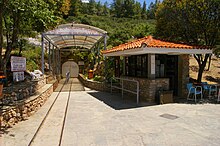Petralona stalactite cave
The Petralona cave ( Greek σπήλαιο Πετραλώνων , Spileo Petralónon even Kokkines Petres , Κόκκινες Πέτρες, Kokkines Petres , "red rocks") is a limestone cave on the mountain Katsika near Petralona (Πετράλωνα, Petrálona ), which on the peninsula Chalkidiki , in the Greek region of Macedonia .
The fossil Petralona 1
In 1959, a resident of Petralonas discovered the cave in which he suspected a source due to a dripping noise. The geologist and cave explorer Ioannis Petrocheilos then explored the various “halls” of the cave, which had remained hidden until then due to a rock fall.
In 1960, Petrocheilus found the completely preserved, fossil skull of a representative of the genus Homo , which was around 30 years old when death occurred , and was sometimes called Archanthropus europeaus petraloniensis (archive number: Petralona 1 ). The skull was dated to be 160,000 to 240,000 years old in 1981, but it may be at least 300,000 years old. The inner volume of the skull is around 1200 cm³ and is similar with other features - u. a. the shape of the bulges above the eyes - Kabwe 1 from Zambia and the fossil Arago XXI from the Tautavel site in southern France . According to both dates, the fossil can be assigned to the late Homo heidelbergensis ; From Homo heidelbergensis , according to the current view, the Neanderthals emerged. It goes with this dating that some features of the skull are similar to those of the Neanderthals, while other features fit much older fossils: "The skull looks as if the face of a Neanderthal man has been transplanted onto the skull of another species." The location of the skull is called the "mausoleum".
Bones of wild animals were found in one of the cave “halls”, the “cemetery of the giants”. The place of safekeeping of the finds is the paleontological department of the Aristotle University of Thessaloniki .
museum
Today, next to the cave passage, there is a museum that exhibits bones, teeth, tools, fossils, etc. It also offers a cave tour through the 800 meter long tour.
literature
- Andreas Neumeier: Chalkidiki. Michael Müller Verlag, 2018, ISBN 978-3-95654-395-1
Web links
- Anthropological Association of Greece: The Petralona Cave. (English) , Greek
- Smithsonian Institution: The Petralona Fossil 1. (with a picture of the skull)
Individual evidence
- ↑ P. Kokkoros and A. Kanellis: Découverte d'un crâne d'homme paleolithique dans la péninsule chalcidique. In: L'Anthropologie. Volume 64, No. 5-6, 1960, pp. 438-446
- ^ GJ Hennig et al .: ESR dating of the fossil hominid cranium from Petralona Cave, Greece. In: Nature . Volume 292, 1981, pp. 533-536; doi: 10.1038 / 292533a0
- ↑ Michael Balter: In Search of the First European. In: Science . Volume 291, No. 5509, 2001, p. 1724; doi: 10.1126 / science.291.5509.1722
- ^ AG Latham and HP Schwarcz: The Petralona Hominid Site: Uranium-Series Re-Analysis of 'Layer 10'Calcite and Associated Palaeomagnetic Analyzes. In: Archaeometry. Volume 34, No. 1, 1992, pp. 135-140; doi: 10.1111 / j.1475-4754.1992.tb00483.x
- ^ Ian Tattersall : The Strange Case of the Rickety Cossack - and Other Cautionary Tales from Human Evolution. Palgrave Macmillan, New York 2015, p. 145, ISBN 978-1-137-27889-0
- ↑ Donald Johanson and Blake Edgar: Lucy and Her Children. 2nd updated and expanded edition, Elsevier Verlag, Munich 2000, p. 214, ISBN 978-3-8274-1670-4 .
Coordinates: 40 ° 22 ′ 28.5 ″ N , 23 ° 10 ′ 0 ″ E


